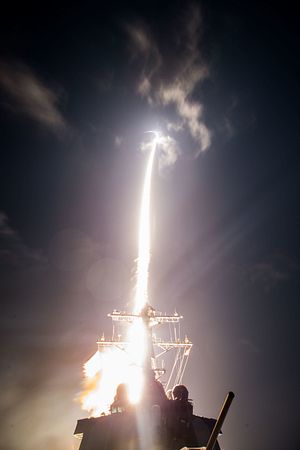The U.S. Navy does not appear to be too happy with the demand its ongoing ballistic missile defense missions pose on its assets and personnel. In comments made last week, covered first over at Defense News, U.S. Chief of Naval Operations Adm. John Richardson outlined a case for why U.S. Navy warships should be weaned off ballistic missile defense patrols, which requires vessels to patrol a fixed area, ready to engage any would-be ballistic missile threats. Richardson made the case for instead focusing on land-based interceptors and sensors to deal with the treat.
Richardson’s remarks, delivered at the U.S. Naval War College’s Current Strategy Forum last Tuesday, emphasized the opportunity costs of ballistic missile defense patrols for the Navy. “Right now, as we speak, I have six multi-mission, very sophisticated, dynamic cruisers and destroyers ― six of them are on ballistic missile defense duty at sea,” he said. “And if you know a little bit about this business you know that geometry is a tyrant.”
By “geometry,” Richardson meant the strict requirements for ship-based ballistic missile defense interceptors to successfully engage their targets. Currently U.S. Aegis-equipped destroyers and cruisers are capable of fielding SM-3 interceptor missiles, which are designed to shoot down ballistic targets in the midcourse phase of flight. The point-of-origination of any given threat — such as North Korea — will determine the patrol box for these vessels. If these vessels patrol outside of these areas or conduct other missions, total U.S. ballistic missile defense capacity in the region would be diminished.
Richardson emphasized this point: “You have to be in a tiny little box to have a chance at intercepting that incoming missile. So, we have six ships that could go anywhere in the world, at flank speed, in a tiny little box, defending land.” Richardson’s proposal was to move over the longer term toward more land-based missile defense solutions, allowing the Navy’s surface combatants to focus on more pressing regional missions, including confronting challenges from Russia and China, both of which were identified as strategic competitors with the United States in the Trump administration’s January 2018 National Defense Strategy.
“It’s a pretty good capability and if there is an emergent need to provide ballistic missile defense, we’re there,” Richardson noted. “But 10 years down the road, it’s time to build something on land to defend the land. Whether that’s AEGIS ashore or whatever, I want to get out of the long-term missile defense business and move to dynamic missile defense.”
Richardson’s remarks last week come as the Trump administration’s Missile Defense Review awaits release. The review, which is expected to focus heavily on ballistic, cruise, and hypersonic threats, including from China and Russia, was expected earlier in the year, but delayed. It’s unclear if the upcoming review will seriously rethink the role of U.S. Navy assets in ballistic missile defense.

































